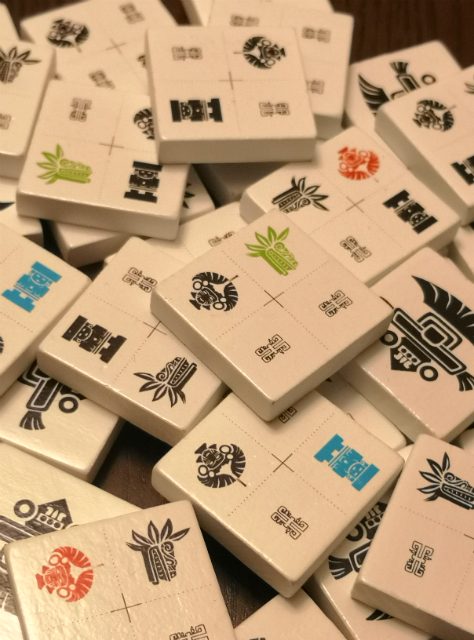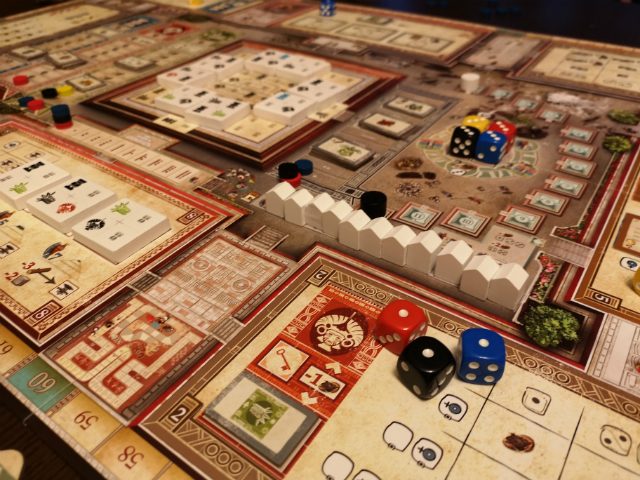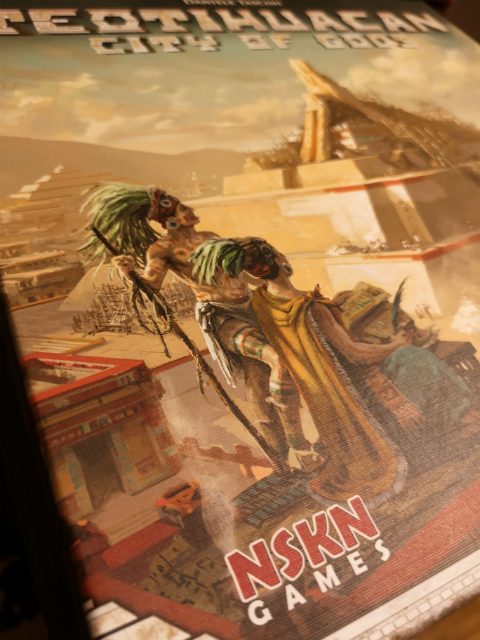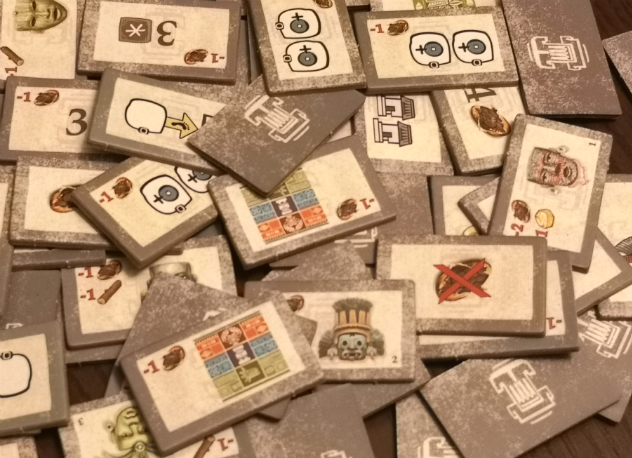At Origins in June, I stopped by the NSKN booth to see what they were showing – I saw a group demo’ing Teotihuacan: City of Gods, and was immediately intrigued by.. well, everything going on! Dice! A lovely board with all sorts of bits and pieces. Pretty art! I was keen to try it, but didn’t have time for a demo. Since then a review copy was whisked my way and I’ve played it a lot – even getting to introduce it to folks at BGGcon. David’s had a good run through of the game, too, so we thought we’d share our thoughts on the game today. 
David: Teotihuacan was designed by Daniele Tascini, who returns to Mesoamerica, which he also explored in 2012’s Tzolk’in. It’s interesting to see where the two designs overlap and where they differ. Both are worker placement games which reward players for long-term planning, but in different ways. In Tzolk’in, the longer you commit your worker ahead of time to an action, the more benefits you can get–but those benefits take longer to materialize, and the worker is stuck there until they do. In Teotihuacan, each additional worker you bring onto a particular action board makes its action cumulatively more powerful–but takes time and meanwhile there’s always something else you’d rather be doing with them.
 Nicole: In a lot of Euro strategy games with many moving parts, you can’t do everything really well, but you can do a few things brilliantly. Teotihuacan is no different. While taking your turn (moving dice workers) is the same thing each turn, you’ll be diving into myriad options. A feature of the board is the pyramid which you can stop to add to, or decorate – each option gaining you a variable number of points, offering a great opportunity to maximize your turn. David: …although pyramid track rewards decrease as the game goes on–an interesting design choice which rewards early commitment. Nicole: I enjoyed the benefits of getting in on the technology bonuses, too – they can really notch up visiting the various spots around the board. David: These can be extremely powerful if taken early–and early adopters get VP bumps from players who get there later. Nicole: Much like its “predecessor”, Tzolk’in, there’s temple tracks in Teotihuacan for players to bump their way up for good stuff. David: These give players valuable rewards not only as they rise through the game but also very juicy endgame scoring.
Nicole: In a lot of Euro strategy games with many moving parts, you can’t do everything really well, but you can do a few things brilliantly. Teotihuacan is no different. While taking your turn (moving dice workers) is the same thing each turn, you’ll be diving into myriad options. A feature of the board is the pyramid which you can stop to add to, or decorate – each option gaining you a variable number of points, offering a great opportunity to maximize your turn. David: …although pyramid track rewards decrease as the game goes on–an interesting design choice which rewards early commitment. Nicole: I enjoyed the benefits of getting in on the technology bonuses, too – they can really notch up visiting the various spots around the board. David: These can be extremely powerful if taken early–and early adopters get VP bumps from players who get there later. Nicole: Much like its “predecessor”, Tzolk’in, there’s temple tracks in Teotihuacan for players to bump their way up for good stuff. David: These give players valuable rewards not only as they rise through the game but also very juicy endgame scoring.
Nicole: winding back from game-end a little, the phases of the game overall are really interesting. I love the way they’re paced over x amount of turns leading up to 2 or 3 “eclipse” mid-game scoring events, and depending on what you’ve been doing you can aim to really squeeze the points out early on. David: The rondel-like action selection combined with the variable action board setup means each player of the game will play very differently. Nicole: This definitely is a huge pro of the game – it means that you won’t “learn” a particular strategy to kill the game every time you play, but will have to act on the go. There’s all sorts of different bonuses, actions and rewards that will show up from game to game and I love the opportunity you get to try them all out.

Nicole: The driving force of the game overall is cocoa – how to get it, what to spend it on, and making sure you’re not running out when you need it most. If you can manage a decent supply, nothing is ever fully blocked to you if you have cocoa to spend. Opponents might end up beating you to certain variable bonuses or point opportunities, but it’s not often you can’t advance your game with a little bean here and there. David: In fact, I think cocoa generation and management is the key to success. Finding an efficient cocoa-generating mechanism means not having to waste a turn collecting it instead of performing an action. The techs that give you extra cocoa on top of resource collection are must-buys, I believe, and anything that boosts you on the green temple track (which grants you some) is also good. Nicole: it’s a really interesting economy for the game – especially when you have to rely on taking a whole turn to get cocoa “income” or rely on rewards/technology bonuses and the like.

Nicole: Now, I mentioned that the look of Teotihuacan was what grabbed my interest first of all. The board itself is pretty large, so expect it to take up some table real estate – but it’s worth it for that lovely pyramid spot in the middle. Lots of the components are nice and tactile wooden bits, and I really love what they did with the pyramid tiles. I was surprised to see they’d gone with just cardboard tokens for cocoa, however, considering the rest of the game’s contents. While the colour palette is not as bright as it could be, given the visual beauty of the culture; but I think that it works well as it is, with pops of colour and incredible detailed art here and there. David: The art and iconography are ok far as they go, but there are some missed opportunities for reminders on action tiles and the board itself of little bits of business that are easily forgettable and/or necessitate looking things up in the rules. For instance, it would have been nice to have a reminder on the Decoration Action tile that building a Decoration moves you up the Pyramid track. Or some player aid cards or tiles with summaries of the different actions and their costs and/or benefits. Also, the iconography on some of the Main Temple worship tile actions is downright confusing and counter-intuitive. Nicole: Definitely some quite obvious versus “ummm, what’s going on here” iconography, for sure. Also, I for sure forgot to use technology bonuses a bunch, but I’m not sure how the game could prompt that, unfortunately.
Nicole: while I’ve really enjoyed this at 3 and 4, I’ve yet to give it a whirl solo, but it sounds great. David: The solo rules (developed by Dávid Turczi, who worked on similar systems for games such as Anachrony) have a bit of a steep learning curve at first (no simple automa here) but they are definitely worth it if you want to play Teotihuacan solo; once you absorb them they really do a good job of simulating another opponent. Nicole: Personally, I’m willing to give it a go just because the AI is called Teotibot, which is adorable. But I also love that they’ve really put in the work to make the solo version stand out. Also a little point I wanted to highlight – when I stopped by to chat to the folks at NSKN’s booth at Origins, I asked a little about the theme and if there’d been any due diligence to ensure appropriate cultural representation. The designer had done a good amount of research to make sure there wasn’t a sort of homogenizing of the representation, which is good to see. The art reflects that, too. I hope they, as a publisher, go forward with this attention to cultural representation (and with living cultures, consultation!).
Nicole: This has really been a hit for me — it’s still fresh after a number of plays! The only other strategy game around this weight that’s felt similarly exciting to get back to the table this year has been Coimbra. If a strategy melange is your taste, then dip into this one.
—
Teotihuacan: City of Gods is a worker placement/action taking strategy game with some tile placement, and plays 1 – 4 people in approximately 90 – 120 minutes. Designed by Daniele Tascini (solo rules Dávid Turczi), with art by Odysseas Stamoglou, it’s published by NSKN Games. Thanks for the opportunity to try the game, and for the review copy!
Comments
No comments yet! Be the first!